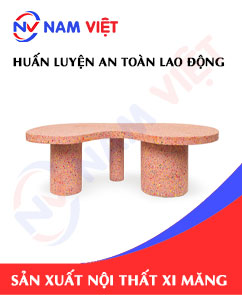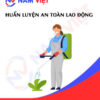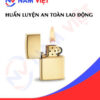Occupational Safety Training for Cement Furniture Manufacturing
99,000 ₫
Note: The above price is calculated for one person, and the price may fluctuate depending on the number of trainees participating in the course and market movements. For more accurate pricing support, please refer to the pricing table or contact our consulting staff directly.
Occupational safety is an important issue in factories manufacturing cement furniture and must be addressed promptly to ensure the health and safety of workers while enhancing the reputation of businesses. The Occupational Safety Training course is one of the effective solutions to increase awareness of how to prevent workplace accidents for workers involved in cement furniture manufacturing.
Table of Contents
Toggle1. Overview of Cement Furniture
a. What is cement furniture?
Cement furniture refers to interior products made from cement, a common construction material composed mainly of cement, sand, and water. Cement furniture products often include tables, chairs, bookshelves, clothes racks, decorative items, and other household items. They are typically designed and manufactured to be visually appealing while also being strong and durable. Cement furniture is widely used in modern interior spaces, providing aesthetic value and uniqueness to living spaces.

b. Types of machinery for cement furniture manufacturing
The machinery and equipment used for producing cement furniture may include:
- Cement mixer: Used to mix the main components of cement, including cement, sand, and water.
- Cement extruder: Used to extrude and compress cement into various shapes and sizes, creating furniture products such as tables, chairs, shelves, and decorative items.
- Cement cutting machine: Used to cut cement into different sizes and shapes according to design specifications.
- Cement polishing machine: Used to polish the cement surface, producing furniture with high smoothness and gloss.
- Cement drying machine: Used to dry cement after extrusion and cutting, ensuring high hardness and durability of the furniture products.
- Support equipment for cement furniture production: Includes other auxiliary equipment such as dust filters, water pressure sprayers, drills, grinders, and welding machines to manufacture high-quality cement furniture.
These machines and equipment are designed to facilitate fast, efficient production while meeting quality standards.

c. Cement furniture manufacturers in Vietnam
Currently, there are many cement furniture manufacturers in Vietnam, among which notable companies include:
-
- Tan Hoang Minh Factory: One of the leading cement furniture manufacturers in Vietnam, offering a wide range of products including tables, chairs, shelves, cabinets, and lamps, produced on advanced production lines.
- Magazine Trading and Investment Co., Ltd.: Specializes in high-end cement furniture with diverse designs, colors, and sizes, used in many large-scale projects in Vietnam and internationally.
- Bao Huy Construction and Trading Joint Stock Company: Produces various cement furniture items, including tables, chairs, shelves, cabinets, and lamps, designed in a modern, elegant, and unique style.
- Minh Viet Manufacturing and Trading Furniture Co., Ltd.: Specializes in high-quality cement furniture, offering a wide variety of models and designs, used in many major projects in Vietnam.
- Homemart International Co., Ltd.: Produces diverse cement furniture items with unique, luxurious, and modern designs.
- Nhat Quang Phat One Member Limited Company is a cement furniture manufacturer with a strong development process guided by a dedicated team and experienced workers. The furniture market in Vietnam is defined by highly skilled designers and quality products.
These are some representative cement furniture manufacturers in Vietnam, though many smaller-scale companies also produce cement furniture.

d. Specific jobs in a cement furniture manufacturing factory
Group 1
- Executive director, deputy director, and department heads in the cement furniture manufacturing factory.
Group 2
- Safety officer: manages safety in the factory, designs safety procedures, monitors and enforces compliance with safe working practices.
Group 3
- Material preparation: Including cement, sand, gravel, water, and other chemicals needed for production.
- Cement mixing: Cement is mixed with other materials to create a lightweight, smooth, and moldable mixture.
- Molding: Molds are designed to cast cement products such as tables, chairs, cabinets, and shelves.
- Product casting: Pouring the cement mixture into molds and waiting for the products to dry and harden sufficiently for use.
- Cutting and finishing: After drying, products are cut and processed to achieve the desired design.
- Painting and finishing: Final products are painted and finished to create visually appealing and durable cement furniture.
- Maintenance and cleaning: Factory staff also maintain and clean machinery and equipment to ensure smooth and safe production.
Group 4
- Office work, support, sales, and marketing.
- Production management, quality management, human resource management, material management, financial and accounting management.
- Research and development of new products, designing packaging and product models.

e. Popular cement furniture products
Popular cement furniture products include:
- Dining tables: Cement dining tables offer a fresh, unique, and elegant look for rooms.
- Sofas: Cement sofas provide comfort while maintaining shape over time.
- Bookshelves: Cement bookshelves are designed with multiple compartments, making it easy to organize and display your favorite books.
- Wardrobes: Cement wardrobes are durable, help preserve clothing, and create a unique living space.
- Flower pots: Cement flower pots are highly durable and suitable for various plants.
- Lamps: Cement lamps are unique and creative interior products that can be designed in various attractive forms.
- Desks: Cement desks are sturdy and aesthetically pleasing, enhancing work efficiency.
- Wine cabinets: Cement wine cabinets serve both storage and decorative purposes in living spaces.
Cement furniture can also be used to create other products such as swimming pool bases, fish tanks, coffee tables, and benches, among others.

2. Overview of occupational safety training for cement furniture manufacturing
This article focuses on Group 3, as Group 3 is directly involved in production and faces the highest occupational safety risks. Refer to other groups here.
a. What is Group 3 occupational safety training?
- Group 3 occupational safety training consists of courses that provide awareness and knowledge on preventing workplace accidents for workers.
- The training helps workers recognize and avoid hazards, minimizing the risks of workplace accidents.
REGISTER FOR OCCUPATIONAL SAFETY TRAINING
b. Training duration
Initial safety training
- Total training time is at least 24 hours, including assessment time.
- 8 hours of theory on safety and labor hygiene policies and laws
- 8 hours of theory on basic occupational safety and hygiene knowledge
- 4 hours of theory on specialized training content
- 2 hours of practical training on specialized content
- 2 hours of theory assessment at the end of the course
The safety training center will schedule multiple sessions depending on workers’ availability. Typically, there are 6 sessions over 3 days if continuous study time is arranged.
Periodic safety training
- Before the occupational safety card expires, workers must complete a periodic occupational safety training of at least 50% of the initial training time.
Explanation: The total periodic occupational safety training lasts at least 12 hours, including assessments. After completing the training and passing the assessment, workers are reissued or renewed their occupational safety cards.
c. Training content
| No. | TRAINING CONTENT | TRAINING HOURS | |||
| Total | Including | ||||
| Theory | Practice | Assessment | |||
| I | Policies and laws on occupational safety and hygiene | 8 | 8 | 0 | 0 |
| 1 | Overview of legal documents and regulations on occupational safety and hygiene. | 6 | 6 | ||
| 2 | Standards and technical regulations on occupational safety and hygiene. | 1 | 1 | ||
| 3 | Specific regulations from state management agencies on occupational safety and hygiene when constructing, expanding, or renovating facilities, and for production, use, storage, and inspection of machines, equipment, materials, and substances with strict safety requirements. | 1 | 1 | ||
| II | Basic knowledge on occupational safety and hygiene | 8 | 8 | 0 | 0 |
| 1 | Basic knowledge of hazardous and harmful factors in the workplace. | 4 | 4 | ||
| 2 | Methods to improve working conditions. | 1 | 1 | ||
| 3 | Safety culture in production and business. | 1 | 1 | ||
| 4 | Rights and obligations of employers and employees; policies and regulations on occupational safety; roles of safety staff. | 1 | 1 | ||
| 5 | Occupational safety rules, signage, and use of personal protective equipment; first aid skills and occupational disease prevention. | 1 | 1 | ||
| III | Specialized training content | 6 | 4 | 2 | 0 |
| Comprehensive knowledge of machines, equipment, hazardous substances; risk assessment and management; safe working procedures with equipment and substances with strict occupational safety requirements. | 6 | 4 | 2 | ||
| IV | End-of-course safety assessment | 2 | 2 | 0 | 0 |
| Total | 24 | 22 | 2 | ||
See more training content for the 6 groups
d. Occupational safety card
After completing the occupational safety training and passing the assessment, workers will be issued an occupational safety card (commonly referred to as Group 3 safety certificate).
The Group 3 safety card includes personal information such as name, date of birth, job, and specific working environment, along with training duration, a red stamp, and signature confirming course completion.
According to regulations in Clause 2 of Article 24, Decree 44/2016/ND-CP, there are two cases:
- If the employer and employee have a labor contract, the employer must sign and stamp the Group 3 safety card after the employee completes the training from the occupational safety training provider and passes the assessment.
- If the worker is freelance or seasonal and does not have a labor contract, the training unit must sign and stamp the safety card after the worker completes the course and passes the assessment.

3. Identifying Hazards Affecting Workers in Cement Furniture Manufacturing
Producing cement furniture also involves several potential hazards that can affect workers’ health and safety, as follows:
- Noise: Operating machinery in a cement furniture manufacturing factory generates high noise levels, which can impact workers’ hearing.
- Dust: During manufacturing, cutting, grinding, and drilling cement can create cement dust harmful to workers’ respiratory systems.
- Heat exposure: Cement curing generates heat, which can cause burns if workers are not properly protected.
- Electricity: Electrical equipment in cement furniture manufacturing factories can pose voltage hazards if not properly maintained and used.
- Chemicals: Some chemicals such as sand, cement, and dyes used in manufacturing can be harmful to workers’ health if not handled correctly.

4. Common Occupational Accidents for Workers in Cement Furniture Manufacturing
Common occupational accidents in cement furniture manufacturing include:
- Fire accidents: Cement furniture manufacturing often requires the use of fire and hot tools for molding and processing products. Failure to follow safety procedures and control fire risks can endanger workers’ lives and property.
- Accidents from inhaling dust and toxic fumes: During cement furniture manufacturing, airborne dust and toxic fumes can be inhaled by workers, causing health problems such as pneumonia, lung cancer, and respiratory diseases.
- Physical injury accidents: Producing cement furniture involves using tools and machinery to cut, mold, and process cement materials. Improper use can result in punctures, cuts, or injuries from falls.
- Accidents from physical load: Cement furniture is often heavy and bulky, requiring workers to move, transport, and install products. Incorrect handling or lifting techniques can lead to load-related injuries or disabilities.
5. Safety Measures When Participating in Cement Furniture Manufacturing
Implementing safety measures during cement furniture manufacturing is essential to protect workers’ health and safety. Key safety measures include:
- Use protective equipment: Workers should wear complete personal protective equipment such as helmets, safety glasses, masks, gloves, protective clothing, and safety shoes.
- Maintain cleanliness and safety in the workspace: The manufacturing area should be clean to prevent slips, trips, and falls. Ensure no materials, documents, or products are scattered or falling.
- Occupational Safety Training: Workers should be trained in safe working procedures and skills, including proper use of machinery and equipment in cement furniture manufacturing factories.
- Regular equipment inspection and maintenance: All equipment and machinery should be routinely checked and maintained to prevent accidents.
- Comply with safety regulations: Workers must follow safety rules and remain attentive. Any safety issues should be immediately reported to supervisors or on-site medical staff.
- Use safe materials: Using certified safe materials such as safe paint, cement, and other manufacturing materials helps reduce health risks for workers and customers.
- Periodically conduct workplace environmental monitoring to collect and analyze harmful factors, then adjust processes to minimize risks and prevent occupational diseases.
6. Benefits of Occupational Safety Training in Cement Furniture Manufacturing
An Toan Nam Viet provides businesses with the following benefits after completing occupational safety training according to Decree 44/2016/NĐ – CP on labor safety and hygiene:
- Workers can identify potential hazards and take preventive measures to avoid accidents.
- Businesses can establish risk prevention measures in manufacturing, operation, and maintenance processes.
- Reduce costs associated with safety incidents.
- Uninterrupted manufacturing improves labor productivity and product quality.
- Compliance with labor safety laws minimizes legal risks.
- Enhances credibility and professionalism, boosting the company’s brand.
Nam Viet’s training programs help individuals prevent external hazards that could result in injury or even death.
REGISTER FOR OCCUPATIONAL SAFETY TRAINING SERVICE
7. Customer Feedback After Completing Cement Furniture Manufacturing Safety Training
An Toan Nam Viet has many years of experience accompanying businesses across Vietnam, especially in the southern provinces. This responsibility is highly valued, which is why Nam Viet’s Occupational Safety Training is increasingly professional. Our growth is driven by positive feedback and constructive suggestions from partner companies. Below are testimonials from clients we have served.
See more customer interviews after using our services at An Toan Nam Viet
8. An Toan Nam Viet’s Occupational Safety Training Capabilities
An Toan Nam Viet is a reputable and high-quality occupational safety training center in Vietnam. Training sessions are continuously conducted at factories, production sites, and construction sites nationwide (all 63 provinces of Vietnam).
REGISTER FOR OCCUPATIONAL SAFETY TRAINING SERVICE
Occupational Safety Training License
- An Toan Nam Viet has been inspected and certified by the Department of Labor Safety under the Ministry of Labor – Invalids and Social Affairs, certifying the center’s eligibility for occupational safety and hygiene training.

Training Materials
- All training materials for occupational safety courses are reviewed to ensure knowledge accuracy and practical effectiveness.
- Instructors use teaching methods standardized by An Toan Nam Viet, developed by experts in occupational safety and hygiene training to maximize learning outcomes.
Facilities
- Controlling classroom factors enhances teaching performance and student knowledge retention.
- Our training facilities provide spacious classrooms meeting standards for area, lighting, and training equipment.
9. Nationwide Reputable and High-Quality Occupational Safety Training Center
At An Toan Nam Viet, occupational safety training is a top priority. We equip workers with the knowledge to protect themselves, contributing to national development.
We carefully prepare every detail to ensure effective training—from tools and equipment to curriculum, materials, audio, and lighting.
Our instructors are experienced experts with research on hazard identification and prevention across industries. Lessons are practical and engaging, ensuring students absorb knowledge effectively, in compliance with Decree 44/2016/NĐ-CP.
Our training center offers the following advantages:
- Competitive training fees without compromising quality.
- Flexible schedules to match company production timelines.
- Fast, legally compliant certification procedures.
- Experienced instructors.
- Classrooms designed to enhance teaching and learning efficiency.
- Lessons tailored for occupational safety in enterprises.
- Dedicated and professional support for clients.

10. Additional References for Cement Furniture Occupational Safety Training Materials
- Cement Furniture Occupational Safety Training Materials
- Complete Occupational Safety Training Documents
- Occupational Safety Training Test Collection
- Cement Furniture Occupational Safety Quiz
- Cement Furniture Occupational Safety Training Slides
1 review for Occupational Safety Training for Cement Furniture Manufacturing
No comments yet















namchinh.haiphong341
Dịch vụ ở đây tốt nhé!